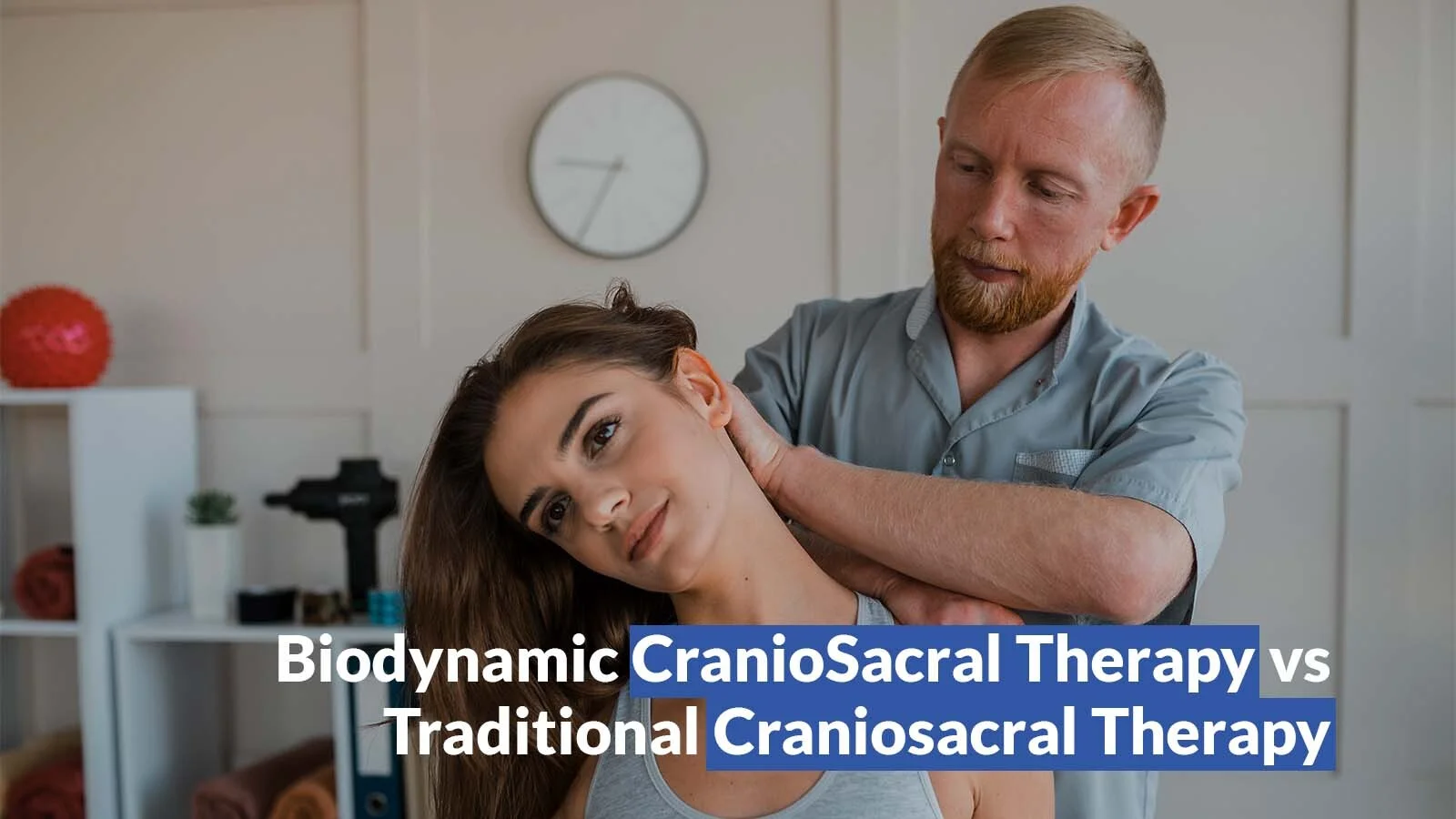Have you heard the term craniosacral therapy but don’t understand what it means? Maybe a friend or relative mentioned cranial work as something that could assist with whatever you are going through, and you are not sure which type of craniosacral therapy would suit you. Biodynamic CranioSacral Therapy and traditional CranioSacral Therapy both originated in the same time period and share many similarities. They are forms of craniosacral bodywork, both being gentle touch therapies, and both originated from osteopath cranial therapy. Patients lie on a massage table (completely clothed) and do not move during their treatments. Both therapies are silent, mild, and can be extremely calming. However, there are a few important differences between them. In this blog post, we will look at these differences to help you decide which method is right for you.






Types of Craniosacral Therapy
If you are searching for relief from chronic pain, stress, or other health problems, you may have already researched Craniosacral Therapy (CST). Now we have two main types:- Biodynamic CranioSacral Therapy (BCST)
- Traditional Craniosacral Therapy (T-CST)
What is Traditional Craniosacral Therapy?
Osteopath Dr. William Sutherland first described Craniosacral Therapy in the early 20th century, having observed the rhythmic movement of the cranial bones and their influence on general health. The craniosacral system involves the cranial bones, spinal cord, and cerebrospinal fluid, CSF. Craniosacral therapy and endocranial therapy use osteopathic cranial manipulation to enhance the flow of the cerebrospinal fluid. Osteopaths, physical therapists, and even massage therapists use craniosacral for migraines, tension headaches, chronic pain, as well as stress. The modern version of the technique was developed by Dr. John Upledger, whose version is often referred to as Traditional Craniosacral Therapy. It talks about the importance of the cranial system and its relationship to overall health and well-being.
Key Features of Traditional Craniosacral Therapy
Shoulder bursitis can show up in different ways, depending upon the intensity and the type.- Direct manipulation of the skull and spine
- Treats physical symptoms such as headaches, neck aches, and other musculoskeletal conditions.
- Uses a non-invasive method and moderate hand pressure to help with cranial and sacral bone mobility.
What is Biodynamic CranioSacral Therapy? for Relief and Recovery
Dr. William Sutherland, a pioneer of osteopathy in the early twentieth century, began investigating the cranial field and developed biodynamic Craniosacral therapy. His earliest work focused on cranial osteopathy, but he later developed a broad approach that integrated all of these natural self-healing abilities of the body. BCST therapy is a holistic approach that takes into account the complete body and its interactions with the environment. Therapists use a soft, listening touch to detect the body’s minute rhythmic motions, referred to as the “breath of life.” Their purpose is to promote the body’s natural healing processes by providing a safe and supportive atmosphere. BCST has benefits for both physical and mental well-being. It helps in the treatment of chronic pain conditions, the release of emotional Psychological trauma, the reduction of anxiety, and the enhancement of flexibility and movement by reducing tension in the body.
Key Features of Biodynamic CranioSacral Therapy
- BCST treats the whole person—body, mind, and spirit—rather than just addressing symptoms.
- Practitioners use a lighter touch, focusing on gentle movements within the craniosacral system.
- The therapy encourages patients to tap into their body’s self-regulatory mechanisms for healing.

Conditions Treated by Both Therapies
These two kinds of therapies can be used to treat a number of conditions, although they may be somewhat different in scope.Traditional CST
Classic CST is often used for more physical conditions such as:- Migraines
- Neck Pain
- Chronic Fatigue
- Fibromyalgia
- Jaw issues (TMJ)
- Post-concussion symptoms
BSCT Therapy
BCST is used for more conditions because it also works on emotional and energetic imbalances.- PTSD and trauma
- Anxiety and panic attacks
- Chronic pain
- Digestive disorders
- Sleeping issues
- Emotional stress
Key Differences Between Biodynamic and Traditional Craniosacral Therapy
Biodynamic Craniosacral Therapy and Traditional Craniosacral Therapy, also known as Biomechanical Craniosacral Therapy, both use natural healing mechanisms, but their methods and philosophies differ.
| Feature | Biodynamic CranioSacral Therapy | Traditional Craniosacral Therapy |
| Approach | Holistic & Energetic | Physical Manipulation |
| Techniques Used | Gentle touch, fluid dynamics | FosteopDirect manipulation |
| Focus | Whole person | Symptom relief |
| Healing Philosophy | Self-regulation | Alleviation of physical symptoms |
| Typical Outcomes | Emotional & physical healing | Physical symptom relief |
Philosophy
The biomechanical method, similar to osteopathy, focuses on structural corrections and direct manipulation of cranial bones and tissues. Biodynamic Craniosacral Therapy differs from traditional physical approaches in that it believes that healing occurs when the body’s inner life energies are activated, allowing its natural intelligence to direct the process.Approach & Focus
The first important difference is one of focus. As the name suggests, traditional craniosacral therapists tend to focus on the head and the lower spine, the sacrum. They usually will spend time holding the head and often also the sacrum. Whereas biodynamic-style therapists could touch anywhere on the body, traditional style craniosacral therapists tend to be more mindful of the rest of the body. These therapists may touch the feet, abdomen, or shoulders, for example, in addition to the head and sacrum.Techniques
As traditional craniosacral therapists manually adjust the body, typically using subtle techniques like mild pulsations on the head or soft movements beneath it, the biomechanical method teaches therapists how to align the body more effectively. This biodynamic method allows the body to release stress in its own way, which can be more beneficial than direct adjustments from the therapist, often leading to surprising results. Therapists do not perform adjustments; instead, they focus on developing hand contacts and enabling the body to heal itself. Biodynamics sees the body as a dynamic, self-repairing system that requires therapists to prioritise non-intervention in order to help patients adjust. The therapist serves as a witness, listener, and spaceholder, acknowledging that healing frequently occurs spontaneously on deeper levels.Choosing Between BCST and Traditional Craniosacral Therapy
One therapy may outweigh the other. It all depends on the kind of treatment you require.- When choosing between Biodynamic CranioSacral Therapy (BCST) and Traditional Craniosacral Therapy (CST), consider which approach suits you best.
- If you want a holistic method that addresses the entire human body and mind, BCST is the right method, particularly for those who respond to gentle touch and allow their bodies to heal naturally.
- If you have specific structural or physical issues like chronic pain, headaches, or spinal problems, traditional CST may be more appropriate. It emphasises body manipulation and re-alignment.
- Check if your practitioner has prior experience with the type of therapy you choose. The practitioner should have a background or training in either biodynamic procedures or traditional craniosacral techniques.
- Some people may tend to relate better with the softer approach of BCST, while others will need a more hands-on approach used in conventional craniosacral therapy.


